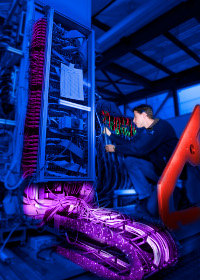 |
 |
|||||||||||||
|
|||||||||||||
|
|||||||||||||
|
Scientists just finished successfully testing the first particle flow algorithm hadronic calorimeter for the International Linear Collider, with unprecedented granularity and novel readout technology. This sub-detector, the analog hadronic calorimeter, was built by the CALICE (Calorimeter for the Linear Collider Experiment) collaboration and is one of several options for the hadronic calorimeter of a future ILC detector. “The data from the tests will provide precise measurements of hadronic showers, which so far have not been available,” said Argonne National Laboratory Physicist Jose Repond, “and we must understand this for the ILC detector design, but also for any experiment that involves hadrons.” The ILC will have both an electromagnetic and a hadronic calorimeter and its highly granular detectors will allow scientists to carefully scrutinise electron-positron interactions at high energies during a collision. This then ends up creating bursts of secondary particles, leptons, and quarks, spraying out from its centre. Scientists will need these new PFA calorimeters to get a three-dimensional image of these particle showers and to identify the origin of the quarks. These quarks produce "jets" of electrically neutral and charged particles that leave their mark in a particle detector. “The main idea behind the PFA,” said Frank Simon, junior research group leader at Max Planck Institute for Physics and the Excellence Cluster 'Universe' in Munich, “is to measure every single particle in the collision as precisely as you possibly can to get the best possible jet energy resolution.” The better that scientists can reconstruct the jet, the more precise is the information they gain about the originating quark and the reactions they are studying. “With all these jets of particles coming out, we need to reconstruct their energies to understand what exactly happened in the collision,” said Repond. The CALICE collaboration, comprising some 280 scientists from 12 countries, is developing the advanced detector technology to actually identify each separate particle in a jet. “The goal of the CALICE collaboration is to evaluate the different ideas for particle flow algorithm calorimetry at the ILC,” said Simon. For both the ECal and HCal, small, advanced light sensors called silicon photomultipliers read out the information from each small scintillator cell. Collaborators have already previously tested an ECal using silicon sensors instead of scintillators. The collaboration will analyse the technical data from tests of all the different technologies in order to demonstrate the validity of the various techniques and determine which modules perform best in providing precise measurements of hadronic showers. They will afterwards start testing a digital hadron calorimeter at Fermi National Accelerator Laboratory which is based on resistive plate chambers (RPCs) and is now under construction at Argonne National Laboratory. Scientists will consider other options such a GEM-based digital HCal, led by the University of Texas at Arlington and a European semi-digital Hcal using resistive plate chambers, in order for them to compare it to the analog Hcal data. These RPCs will actually be inserted in the same iron absorber structure that was already used for the analog HCal. “The goal is to take data with all these different options under very similar conditions, to be able to compare and to decide which is the best technology for the ILC,” said Simon. -- Andre Sulluchuco Read also Frank Simon's blog: www.quantumdiaries.org/author/frank/ |
|||||||||||||
| © International Linear Collider |

